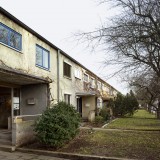Nidder Valley, Heddernheim, Frankfurt, Germany
Located on the site of a first century Roman town, Römerstadt was built as one of a series of satellite settlements in the Nidda Valley around Frankfurt.
Ernst May prepared plans for the sites as part of Ludwig Landmann’s wider ‘New Era’ cultural and economic reform of the area. Römerstadt updated the Garden City look, with strong Modernist architecture but followed its principles including the availability of allotments and gardens to create a self-supporting community
Early 1926 - May and Herbert Boehm readied a detailed proposal for the Nidda Valley satellite
Late 1926 - construction begins
1928 - completed within a single building campaign, bulk of housing built in 1928 – economic problems hindered and constrained the intricate site planning.
Original master planner and any other critical master planning, design and architects
Ernst May, planner (spent 2 years working with Unwin) Herbert Boehm and Wolfgang Bangert, part of Ludwig Landmann’s wider ‘New Era’ cultural and economic reform of the area
Buildings designed by May and Carl-Hermann Rudloff. Also involved Martin Elsäesser, Karl Blattner (local architect), Gustav Schaupp (local architect) and Franz Schuster.
Leberecht Migge responsible for landscapes and gardens.
Architectural Style/qualities
Classical Modernism
Incorporated details of Hampstead Garden Suburb e.g. boundary walls.
First fully electrified settlement in Germany.
Settlement Size:
1220 residential units built originally
Population: 2493
Other notable features that reflect Garden City Principles:
opportunities for residents to grow their own food, including generous allotments
Allotments and gardens for self-supporting community
Beautifully and imaginatively designed homes with gardens, combining the very best of town and country living to create healthy homes in vibrant communities
Housing built to be space and labour saving with latest modern conveniences
mixed-tenure homes and housing types that are affordable for ordinary people
Housing schemes were designed for varied social use e.g. old people, single women and families at different income levels.
Find out more
Bürgerberatung (Citizens Advice)
http://www.frankfurt.de/index2.html
Also:
http://frankfurtammain.mobi/sixcms/detail.php?id=2727&_ffmpar[_id_inhalt]=102443
http://ernst-may-gesellschaft.de

